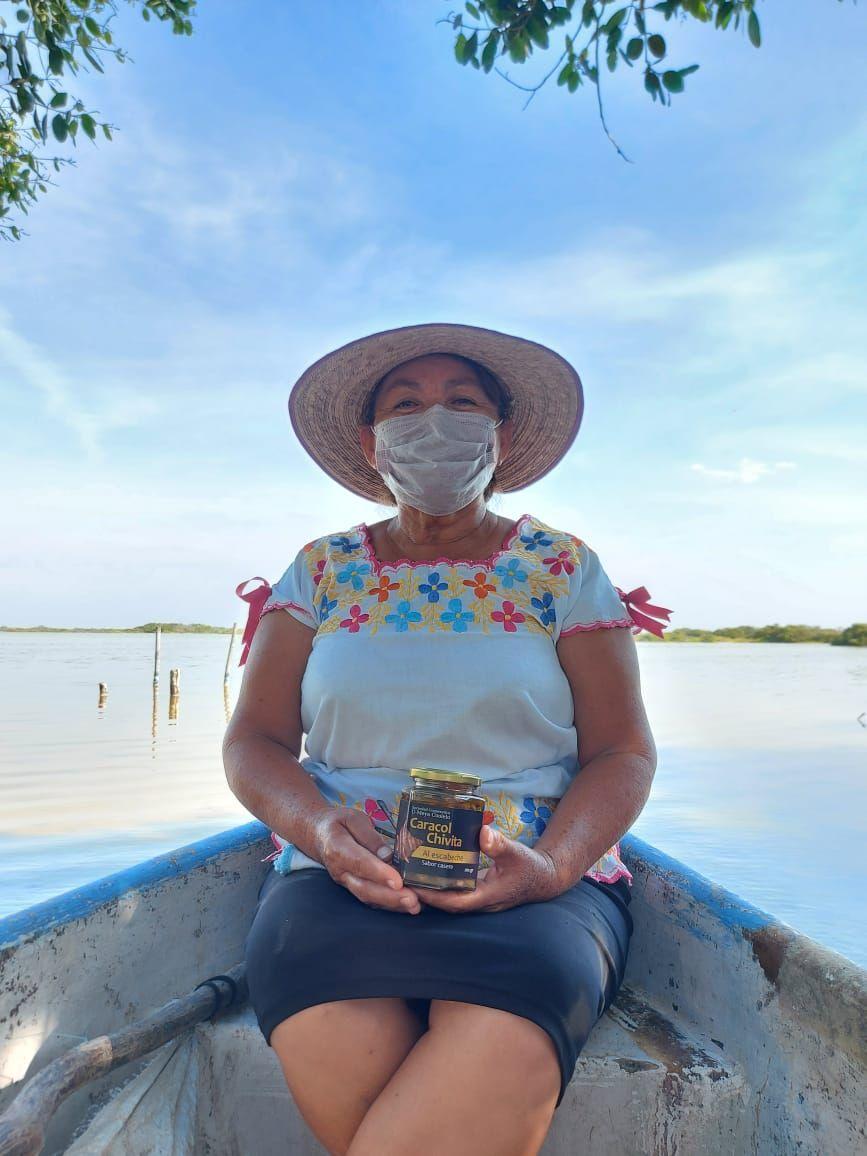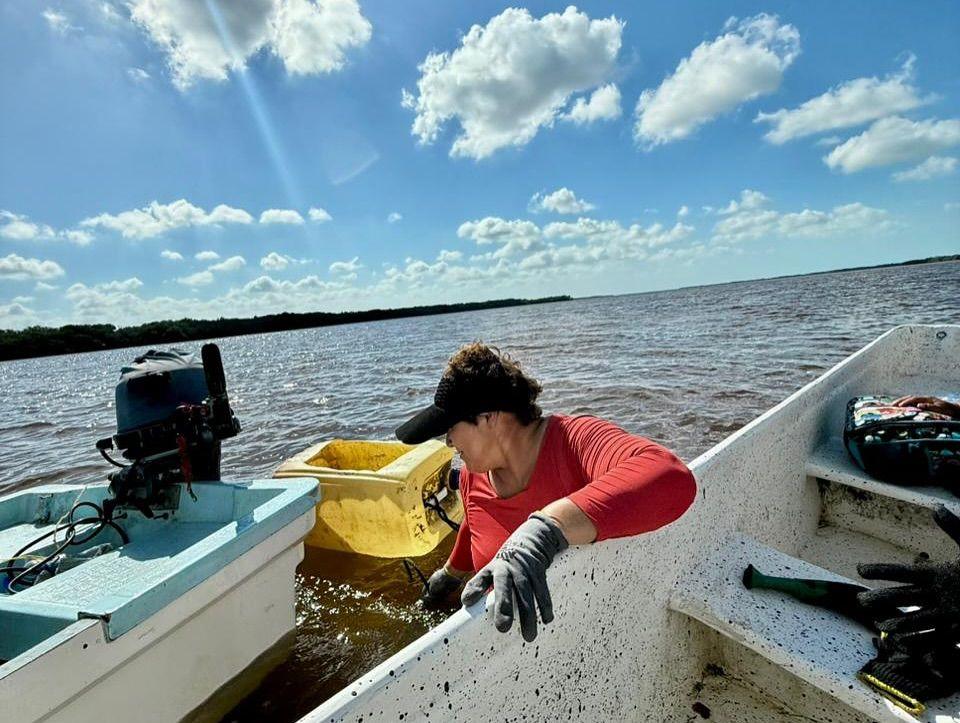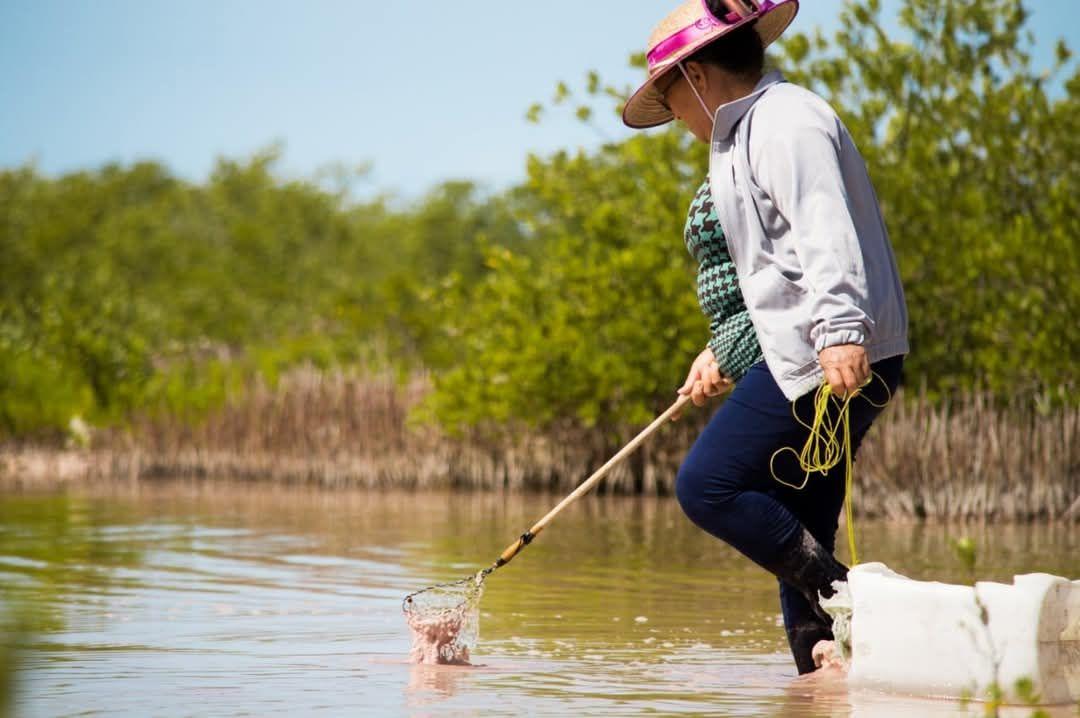Although the capture of the Chivita snail is prohibited because it is permanently banned, fishing communities in Yucatán, Mexico, extract it as a source of food for survival. Experts warn that the solution is not a strict prohibition, but a regulation built on the basis of a community approach that listens to those who depend on the sea.
Fishermen Marina Aguilar de Progreso and Ramiro Santos de Celestún, whose names we changed so as not to stigmatize them, explained to this media outlet that the capture of chivita occurs in communities.
Santos serves ceviche while sharing problems in his territory. The food contains fish, shrimp and chivita, scrambled with the ingredients needed for the dish.
“Yes, we know that the chivita is permanently banned; we cannot fish it, but the truth is that all people continue to eat because of their habits and customs,” Santos revealed.
The fisherman shared that the fishing technique is simple: cut drums, ropes, and a lot of patience. Once out of the water, the snails are “chipped” with boning needles to extract the pulp and the shells are kept for handicrafts.
 Despite the ban, people from fishing communities consume chivita. Source: Ramiro Santos.
Despite the ban, people from fishing communities consume chivita. Source: Ramiro Santos.
The scene is repeated in other coastal communities. Aguilar, for her part, shared that, when she can, she organizes with other women to go to the swamp in Progreso to collect. It is an activity carried out in coastal areas by girls, boys, older adults and mothers of families, sometimes with sons or daughters in their arms.
“We're still eating it here. There are those who do sell it right here in the community, but we can't do a very open sale because we know it's forbidden,” he said.
Although the capture of Melongena corona bispinosa —the scientific name of the species—has been restricted in Yucatán since 1994, its consumption and informal sale persist. Social networks abound with offers of cooked and minced chivita between 100 and 250 pesos per kilo.
 Cooked snails are offered on social networks. Source: Facebook.
Cooked snails are offered on social networks. Source: Facebook.
This type of snail belongs to the group of mollusks. It is dark in color and has a cone-like appearance. In Mexico, it is distributed in Veracruz, Campeche and Yucatán. Fishermen claim that it is found in sandy and muddy soils, mainly in swamps.
In Campeche, all snail species are temporarily closed from January 1 to March 14 and from July 16 to December 31 of each year; in Quintana Roo there is a temporary ban throughout the month of February and from May 1 to November 30 of each year for pink snails, in accordance with the Update of the National Fishing Charter in 2025.
 The chivita is mainly distributed in Veracruz, Campeche and Yucatán. Source: iNaturalist Mexico.
The chivita is mainly distributed in Veracruz, Campeche and Yucatán. Source: iNaturalist Mexico.
In Yucatán, fishing for chivita is prohibited, except for those who comply with the Official Mexican Standard NOM-013-SAG/PESC-2016, with which permits are granted to catch snails using artisanal methods such as manual harvesting in a low tide area, in addition to respecting the minimum size allowed, which for chivita is 4 centimeters.
Today, only the Sociedad Cooperativa de Producción Pesquera U-Meya Coleelo S.C. de R.L has a permit to catch and trade chivita.
 Mayri Beatriz is one of the few women allowed to fish for chivita. Source: U-Meya Coleelo Cooperative Fishery Production Society.
Mayri Beatriz is one of the few women allowed to fish for chivita. Source: U-Meya Coleelo Cooperative Fishery Production Society.
Mayri Beatriz Espadas Narváez, a woman of Mayan origin, is part of this cooperative that began with 15 women who had always dedicated their lives to capturing the chivita.
“At the beginning it wasn't easy to get us the permissions because you can see that women always put obstacles in our way, but we never take our finger off the line,” she said.
For the procedures to obtain a fishing and trading permit, they pay four thousand pesos each year. It is profitable for them because with the document they sell even outside the state. This way they managed to get a buyer from Minatitlán, Veracruz, to pay them for the shell.
Mayri, at 60 years old, has verified that the species is self-sealing because in rainy seasons and hurricanes, the snail does not come out, but is kept.
Fishing schedules vary, but women from the cooperative usually leave their homes before five in the morning because the chivita begins to be dug up early, so by ten o'clock they may have finished their day.
On a good day, each woman can fill up to five buckets with an average of three kilograms of snails each.
“In one day you can catch up to 15 kilos of chivita, but there are bad days when you can only catch one or two kilos, or you only find 10 chivitas. It depends a lot on the weather,” he said.
For Mayri, it is a future dream to have a collection center to market her product with a sustainable perspective.
 The women in the cooperative dream of distributing their value-added products. Source: U-Meya Coleelo Cooperative Fishery Production Society.
The women in the cooperative dream of distributing their value-added products. Source: U-Meya Coleelo Cooperative Fishery Production Society.
“We would like to employ more women because in the community there are single mothers, widows, many others are young people who study, so we hope in God that in the future there will be opportunity, because we work to give added value to the species that allows us to provide for our family,” she said.
In 2019, Mayri was one of the winners of the Sustainable Fisheries and Aquaculture Award awarded by the federal government for the management of innovative productive practices in the fishing and aquaculture sector, and the care of natural resources. The following year, she won first place at the state level as the exemplary woman in fishing with a project in which she cooked pickled and garlic chivitas.
Despite the ban, fishing continues unregulated
Apart from the case of the U-Meya Coleelo cooperative, fishing continues unregulated in Yucatán.
Researchers at the Center for Research and Advanced Studies (Cinvestav) have records that show that in Chuburná Puerto alone, a fishing community of more than two thousand inhabitants, 70% of them are engaged in the artisanal capture of chivita all year round.
Claudia Yamily González Góngora, president of the Yucatán delegation of the National Chamber of the Restaurant and Spicy Food Industry (Canirac), commented that the consumption of this snail is prohibited in the restaurant sector.
“Since chivita and snails are constantly banned, it would be illegal for any restaurant in the state to offer it and even more so, to serve it. The law is clear in this regard and we trust that those who commit an illegality will have the consequences that the law dictates,” he said.
However, in canteens and restaurants on the coastal strip, it is still offered as snacks or as another ingredient in ceviches and cocktails.
“The restaurants here continue to be served, not in all of them, but in several, but more than in restaurants, we almost always fish just to eat at home,” confirmed Ramiro Santos.
 Women use drums to collect the snail. Source: Sepase.
Women use drums to collect the snail. Source: Sepase.
Rosario Gómez*, from the port of Celestún, mentioned that they currently spend about five hours a day in the municipality to extract between three and 12 kilograms, from April to July. Just to get one kilogram you need about 300 chivitas.
The people interviewed confirmed that they do not know that there are special permits for regulated capture of chivita; only that it is a species under permanent ban.
Is chivita aquaculture viable
Dalila Aldana Aranda, a researcher at Cinvestav, a member of the Department of Marine Resources, warned that the species lives under constant stress due to overfishing in Celestún, Sisal, Progreso, Chicxulub Puerto and Rio Lagartos.
The specialist considered that currently the laws for its exploitation are confusing, which does not allow for regulation that protects the species.
“It is known that it is permanently banned because it is included in the snail block where a series of species enter, but there are other regulations in which there is no mention of the chivita in particular. For me, there must be a real commitment on the part of the local government and the National Aquaculture and Fisheries Commission to bet on sustainable fishing and aquaculture of this species,” he said.
The scientist shared that at Cinvestav they have already carried out studies that prove that it is possible to perform chivita aquaculture.
“It's a noble species in the sense of its domestication, that is, its cultivation is feasible; but you can't ask the fisherman to invest 20,000 pesos for a farm if he doesn't have the money, so that resource has to come from the State, especially if there's already scientific proof that the population can apply it,” he added.
The crop would allow traceability, added value and the possibility of preserving the culinary tradition: chivita pickled, in pibil, with achiote, in jars.
“This way, there would be a way to certify that the product is not extracted from nature but that it comes from a farm. For this purpose, permits would also have to be granted to fishermen,” he said.
For more than a decade, the Cinvestav Marine Biology Laboratory has developed scientific knowledge on population dynamics, rehabilitation areas and ecophysiology studies have been carried out to demonstrate that chivita can withstand a wide range of environmental conditions, making it an excellent candidate for cultivation.
 Most of them are women who fish for this species of snails. Source: Sepase.
Most of them are women who fish for this species of snails. Source: Sepase.
Regulation with a community perspective is urgently needed:
Eduardo Batllori Sampedro, researcher at Cinvestav, from the Department of Human Ecology, commented that this species has nutritional, nutritional and economic value, particularly for families in precarious conditions.
“When the ban was established, there were no consultations with people from the original communities. The authorities did not study the importance of these species in inland waters for families and thus violated their human rights to food and to the social ownership of an environment that provides them with food,” he said.
The researcher commented that more attention is currently being paid to the recovery of commercial species such as octopus, grouper and lobster, but with the chivita snail it is possible to exploit them from a community perspective.
“It is very difficult to break with the centralized vision of resource conservation and to privilege production for the international market. There must be a change in the ways of understanding food sovereignty. Communities depend on biodiversity and at the same time they are guarantors and guardians,” he said.
* This article was written by Itzel Chan, who covers coastal communities thanks to the support of the Report for the World program .




Comentarios (0)